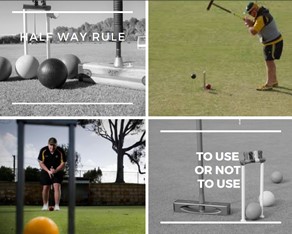Half Way Rule – To Use Or Not To Use

I liken the merits of the halfway rule to that of shooting into a corner in AC. You are basically conceding the hoop. It should only be taken if all other options are totally exhausted or too risky for that stage of the game. The exception is if you control the current hoop (jawsed or in front but unclearable) and are setting up for the next as well.
At the central hoops going half way can actually prove beneficial as the chance of scoring/jawsing hoops 6 or 12 on your next turn is greater. You also have a chance to block/wire a hoop 5 jawsed ball from the next hoop as the centre peg becomes your ally.
When you intentionally go half way/concede the hoop (usually only when your opponent is jawsed and un-hit/jumpable) there are a couple of wiring positions to consider. Once again have a purpose… don’t just go half way!
1. Odd jawsed hoops.
On odd jawsed hoops try to wire the jawsed ball from getting good position on the next hoop. This can be done at the halfway mark or more accurately closer to the jawsed ball. You have conceded the hoop but you have stopped the opponent from having a free shot on the next one.
2. Even jawsed hoops.
On even jawsed hoops you are wiring the opponents open ball from being able to make good position in front of the next hoop. You are trying to force your opponents first ball to the next hoop to go wide of the hoop or to the non scoring side.
Although you have conceded the hoop you are hopefully dictating the terms of the next hoop before the current one is even scored.
I usually attempt the above options if my balls were fairly apart from each other. If they were closer, but in bad positions to jump or clear the jawsed ball I might also consider these options as well:
1. Promotion. I will look for the promotion on odd jawsed hoops as the promoted ball can be used to clear the opponent from in front of the next one (defend the scoring zone). I wouldn’t usually bother with even hoops as it is not worth jeopardising the chance to get first position in front of the next hoop. I will look for promotions only if my balls are close enough together that I can place them in a perfect promotion/rush position for the next hoop. If you are not good at rushing then this is not the best option for you. I call these promotions “defensive promotions” as your main goal is not to score off the promoted ball (unless you can!) but to clear or stop the previously jawsed ball from its likely scoring position on the next hoop; you are trying to win back the power of a hoop that should have been yours anyway.
2. Anti- Promotion. This means disrupting your opponent and trying to stop them dictating play. This means clearing your opponents second ball (not the jawsed or scoring one) such that it cannot
a. Promote the jawsed ball to the next hoop on odd hoops,
b. Promote the jawsed ball to the next hoop after hoop has been made on even hoops,
c. Rush the jawsed ball through an even hoop and ricochet towards the next hoop itself.
3. Ricochet. Look to get a ricochet off your opponent’s ball towards the next hoop. I especially love it if my opponent has gone halfway as I will tend to shoot on this ball if close enough. If you ricochet well enough it may make your opponent leave the jawsed ball in the jaws and not score on that turn. On odd jawsed hoops your balls are likely to be in a better position to clear the jawsed ball than they were when you conceded the hoop initially.

